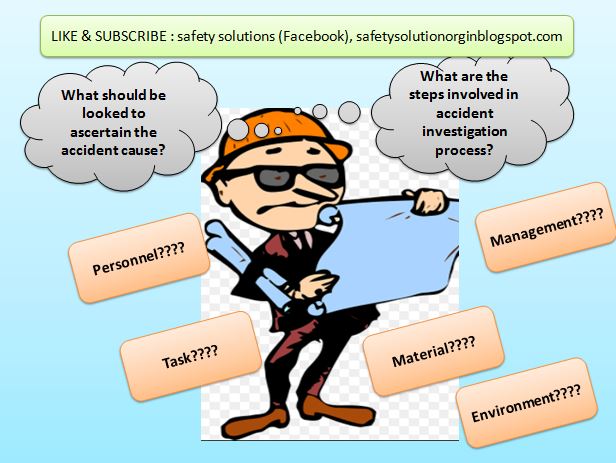What should be looked to ascertain the accident cause? What
are the steps involved in accident investigation process?
Accident investigation initiated with the information
collection, witness interview, facts finding etc. Now the main attempt is to be
done to analyze the root cause of the accident. Causes are of two type surface
causes and root causes. Surface cause is not so difficult to identify.
A Surface cause example is broken machine guard lead to
accident, removed machine guard lead to accident.
Now main issue is to ascertain Root cause of the accident.
One of the techniques to ascertain root cause of any accident is asking why
.i.e. 5 Y’s. Asking why question on the situation can help investigator to
ascertain the root cause of the accident.
Root causes are the cause which are not apparent or are seen
immediately but are the key contributor to any accident. Example of root cause
can be management failure, human error, Design failure etc. They are of two
types System absence and system presence with absent implementation.
Example to differentiate Surface cause and Human error using
below accident:
One day Mr. Mike was driving a locomotive engine from Vege,
UK towards London. Suddenly he pressed a button which results into inadvertent
movement of the locomotive. This inadvertent movement ultimately led to an
accident.
Q1- What are the surface causes and root cause of the
accident?
Ans1- Investigator collects the data, analyses the facts and
found that during pressing the button inside the locomotive to reduce the speed
of the engine it seems he pressed the button which led to inadvertent movement
of the locomotive. During the analysis it has been seen that button location is
incorrect ergonomically. Operator has to overreach to press the button and
button is not clearly visible from the ground.
Surface Cause: Human
error .i.e. Incorrect switch pressing.
Root Cause: Design failure .i.e. Incorrect Ergonomics (Good
fit between operator and its machinery)
So, using why-why questioning methodology one can determine
the root cause of the accident.
Why 1- Why did accident happen?
Ans 1- Because of locomotive inadvertent movement.
Why 2- Why was inadvertent movement happened?
Ans 2- Because operator pressed the wrong button.
Why 3- Why he pressed the wrong button?
Ans 3- Due to overreach to button, poor visibility led to
incorrect selection.
Why 4- Why overreach?
Ans 4- Poor ergonomics of the workplace.
Root Cause is Poor ergonomics.
So, it is clear that here system weakness led to an
accident. Root cause can be of two types. First one is presence of System weakness
and second one presence of strong system but absence of its implementation.
NOTE: It is not necessary that why-why should be done 5
times. It can be less than 5 times or more than also.
So now it is management responsibility to mitigate risk by
applying hierarchy of control measures. Here we should apply engineering methods
to improve the workplace design and ultimately easy button operation for
locomotive.
Here it ends. Please note that above explanation is very
simple and it is for understanding only. It can be done in detail and complex
manner also which depends on the competency of individual.
Now it is time to understand the steps involved in
investigation process.
1-
Background information: 4W and 1Y- Who, What, Where,
When and Why. It means here we will write what was happened and when. Who was
the victim and where was the accident happened?
2-
Description of the accident: Sequence of events
written down to ascertain the clear picture of the actually what was happened?
3-
Findings: Here we write surface and root cause
(As described above)
4-
Recommendations: Hierarchy of controls led to an
action plan for prevention of similar accident.
5-
Summary: Cost benefits analysis of the actions
and their advantages.
Hazardous conditions which caused the accident may exist in
any forms. These are as below:
Materials, machinery, equipment, tools, chemicals,
environment, workstations, facilities, people, workload.







"Great Information! Useful for me to develop my knowledge. Thank you!
ReplyDeleteNebosh IGC in Chennai
International Safety Courses
Process Safety Management Certificate
Nebosh Courses In Chennai
NEBOSH HEALTH AND SAFETY LEADERSHIP
Fire Safety Course In Chennai
"
You have very informative blog and even layman like me can also understand most of it.. I am very happy that my google search landed me here, way to go keep sharing such useful blogs.
ReplyDeleteAlso check our safetyfirstindia
Safety First India is a leading Industrial Safety Company in Delhi as well as Dealer for Covid-19 Safety Products in Delhi and Supplier for Fire Safety Equipment's in Delhi and also Manufacturer for Electrical & Fall Safety Products in Delhi.......!